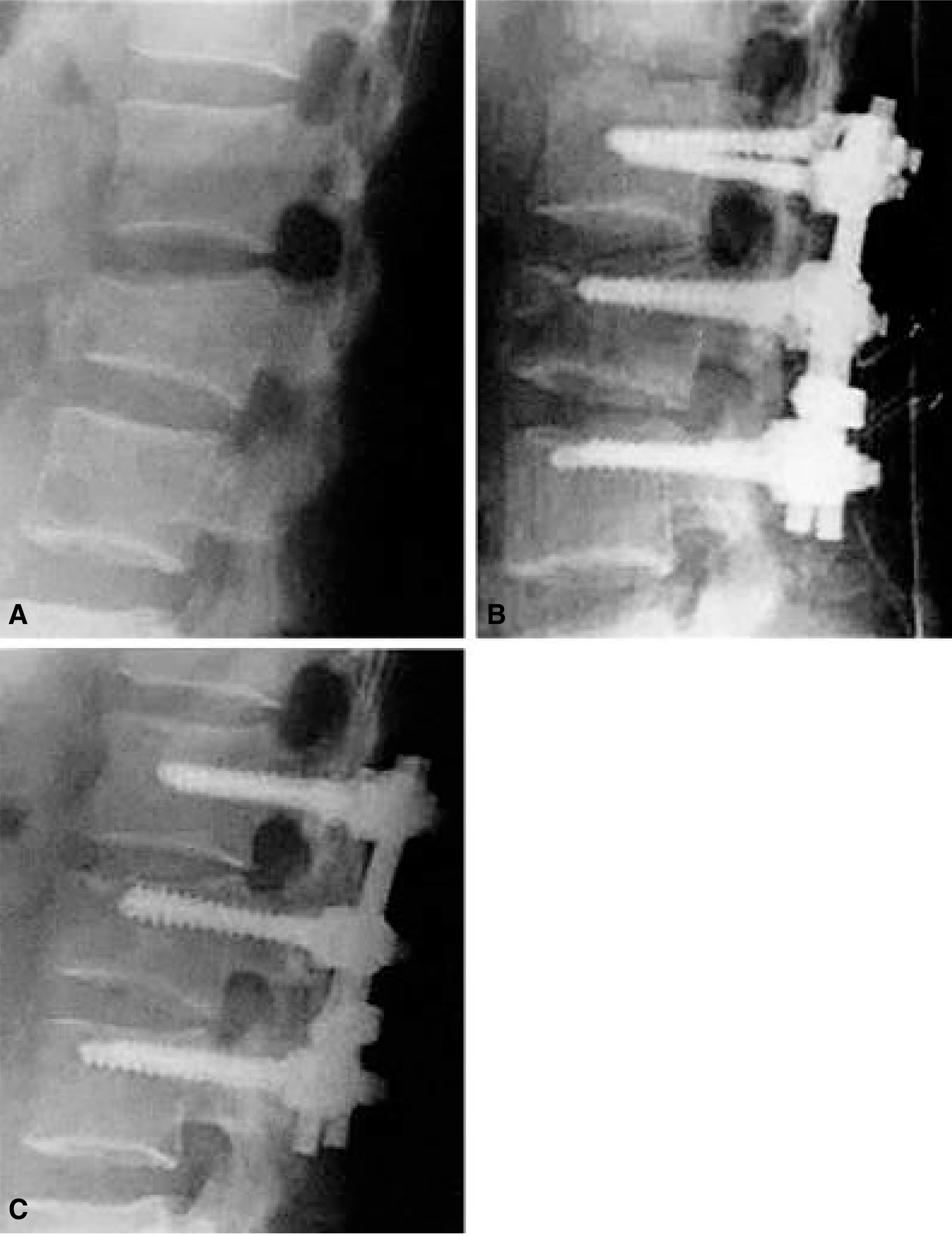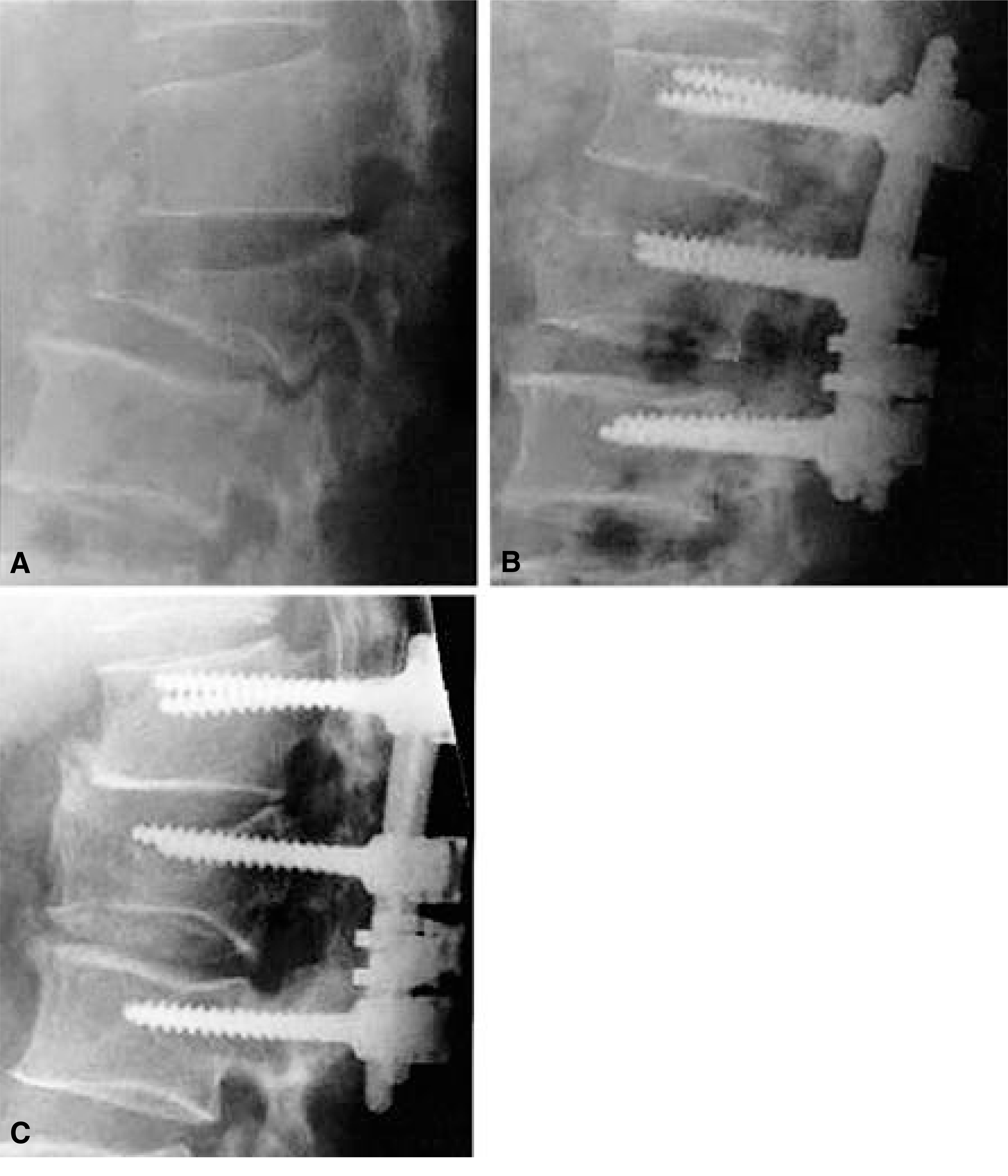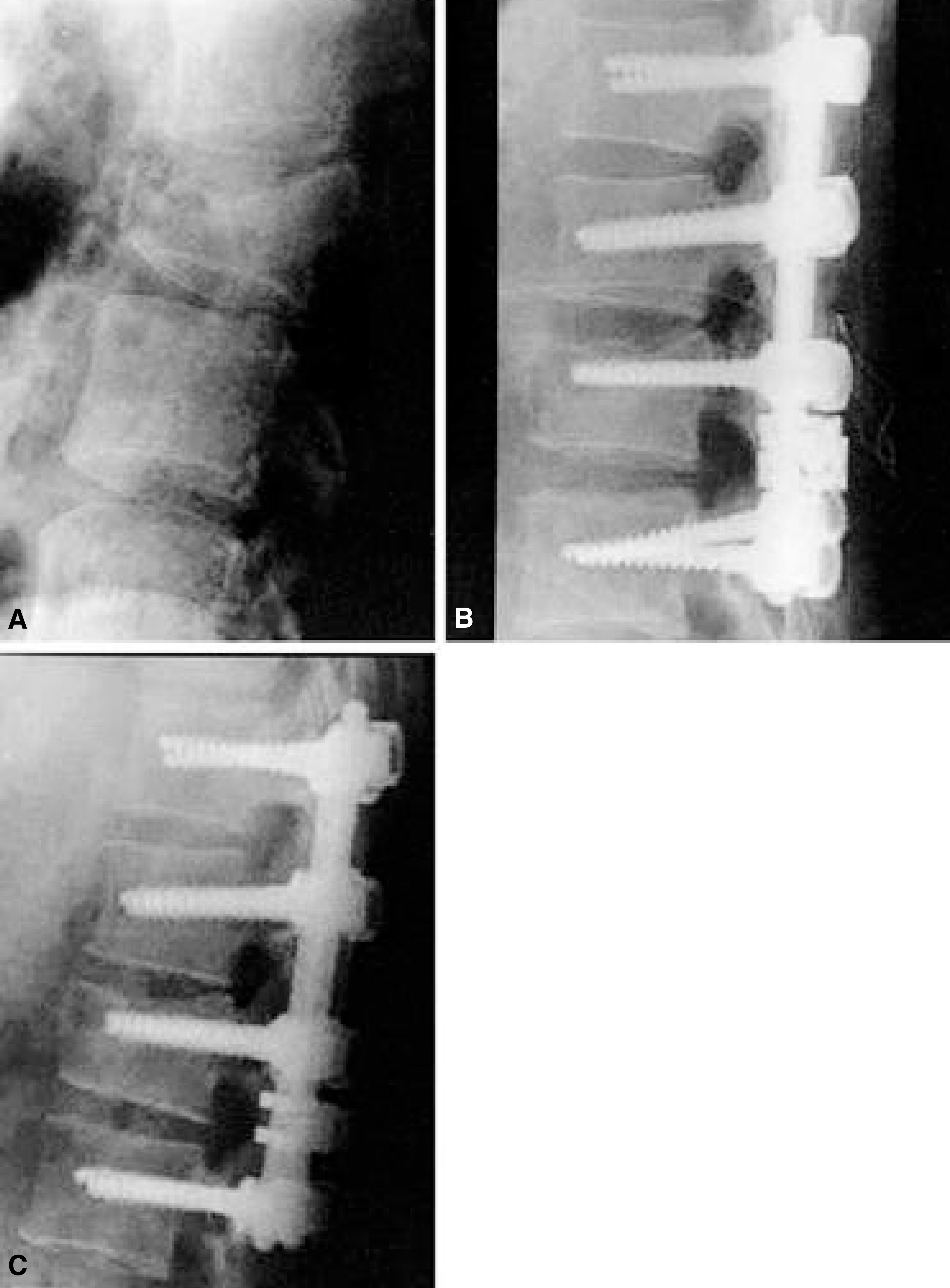J Korean Soc Spine Surg.
2001 Mar;8(1):27-38.
Decision of Posterior Fixation Level by Load-Sharing Classification in Thoracolumbar and Lumbar Burst Fracture
- Affiliations
-
- 1Department of Orthopaedic Surgery, Samsung Medical Center, Sungkyunkwan University, School of Medicine, Seoul, Korea. csl@smc.samsung.co.kr
Abstract
-
STUDY DESIGN: Retrospective study on 54 thoracolumbar and lumbar burst fractures treated with pedicle screw instrumentation.
OBJECTIVES
To decide the optimal level of fusion in thoracolumbar and lumbar burst fractures treated with pedicle screw instru-mentation by load sharing concept. SUMMARY OF LITERATURE REVIEW: Short segment pedicle screw fixation is condemned with frequent failure in maintenance of reduction. The type of posterior fixation construct that is most desirable is less well defined.
MATERIALS AND METHODS
Using the Load-Sharing classification, Group I consisted of 24 cases with fractures totaling 6 points or less underwent surgery which was subdivided into two subgroups(A : 1 level above and below including fractured vertebra, B : long segment fixation). Group II consisted of 30 cases with fractures totaling 7 points or more underwent surgery which was sub-divided into three subgroups(C : 1 level above and below including fractured vertebra, D : 2 levels above, 1 level below including fractured vertebra, E : 2 levels above and below the fractured vertebra). Change of segmental kyphosis, inter-screw angle, upper disc height, lower disc height and anterior body height were measured using post-operative and follow-up lateral radiographs.
RESULTS
Comparing two subgroups in group I(A Vs. B), group A showed definitely more loss of upper disc height than group B but the others were not significantly different. Comparing three subgroups in group II(C, D, E), group C showed definitely more loss of reduction than two other groups but loss of anterior body height was not significantly different. There were no significant differences between group D and E.
CONCLUSIONS
For fracture totaling 6 points or less, the long segment fixation(2 level above and 1 level below including fractured vertebra) is a successful method at thoracolumbar junction and short segment fixation to preserve motion segment at lumbar spine. For fracture totaling 7 points or more, short segment fixation is inappropriate and long segment pedicle screw fixation (2 level above and 1 level below including fractured vertebra) could effectively treat burst fractures of thoracolumbar and lumbar spine.
Keyword
Figure
Reference
-
1). 신병준, 김대성, 최창욱. 척추경 나사못 고정기기를사용해 치료한 척추 골절에서 교정 소실에 대한 분석.대한척추외과학회지. 1:223–232. 1994.2). Been HD and Bouma GJ. Comparison of two types of surgery for thoracolumbar burst fractures: combined anterior and posterior stabilization Vs. posterior instrumentation only. Acta Neurochirugica. 141:349–357. 1999.3). Carl AL, Tromanhauser SG and Roger DJ. Pedicle screw instrumentation for thoracolumbar burst fractures and fracture-dislocations. Spine. 17:S317–S324. 1992.
Article4). Cotrel Y, Dubousset J and Guillaumat M. New universal instrumentation in spinal surgery. Clin Orthop. 227:10–23. 1988.
Article5). Esses SI, Botsford DJ and Kostuik JP. Evaluation of surgical treatment for burst fractures. Spine. 15:667–673. 1990.
Article6). Krag MH. Biomechanics of thoracolumbar spinal fixation. Spine. 16:584–599. 1991.
Article7). Mann KA, McGowan DP, Fredrikson BE, Falahee M and Yuan HA. A biomechanical investigation of short segment spinal fixation for burst fractures with varying degrees of posterior disruption. Spine. 15:470–480. 1990.
Article8). McCormack T, Karaikovic E and Gaines RW. The load sharing classification of spine fractures. Spine. 19:1741–1744. 1994.
Article9). McLain RF, Sparling E and Benson DR. Early failure of short segment pedicle instrumentation for thoracolumbar fractures. J Bone Joint Surg. 75-A:162–167. 1993.10). McNamara MJ, Stephens GC, Spengler DM. T ran spedic -ular shortsegment fusions for treatment of lumbar burst fractures. J Spinal Disord. 5:183–187. 1992.11). Müller U, Berlemann U, Sledge J and Schwarzenbach O. Treatment of thoracolumbar burst fractures without neurologic deficit by indirect reduction and posterior instrumentation. Eur spine J. 8:284–289. 1999.12). Parker JW, Lane JR, Karaikovic EE and Gaines RW. Successful short segment instrumentation and fusion for thoracolumbar spine fractures. Spine. 25:1157–1169. 2000.13). Pool HA and Gaines Jr RW. Biomechanics of transpedicular screw spinal implant systems. Spine. 6:27–43. 1992.14). Roy-Camille R, Saillant G and Mazel C. Internal fixation of the lumbar spine with pedicle screw plating. Clin Orthop. 203:7–17. 1986.
Article15). Shono Y, McAfee PC and Cunningham BW. Experimental study of thoracolumbar burst fractures. Spine. 19:1711–1722. 1994.
Article16). Sjostrom L, Jakobsson O, Karlstrom G, Pech P and Rauschning W. Spinal canal remodeling after stabilization of thoracolumbar burst fractures. Eur spine J. 3:312–317. 1994.17). Sjostrom L, Karlstrom G, Pech P and Rauschning W. Indirect spinal canal decompression in burst fractures treated with pedicle screw instrumentation. Spine. 21:113–123. 1996.
Article18). Steffee AD, Biscup RS and Sitkowski DJ. Segment al spine plates with pedicle screw fixation. A new internal fixation device for disorder of the lumbar and thoracolumbar spine. Clin Orthop. 203:45–53. 1986.
- Full Text Links
- Actions
-
Cited
- CITED
-
- Close
- Share
- Similar articles
-
- More than 5-Year Follow-up Results of Two-Level and Three-Level Posterior Fixations of Thoracolumbar Burst Fractures with Load-Sharing Scores of Seven and Eight Points
- Comparison of Short Segment and Long Segment Posterior Instrumentation of Thoracolumbar and Lumbar Bursting Fractures at Load Sharing Score 7 or Above
- Treatment of Thoraco-Lumbar Bursting Fractures According to Load-Sharing Classification
- Differences of Fracture Patterns by the Level of the Thoracolumbar and Lumbar Burst Fractures
- Comparision of Classifications in the Thoracolumbar Burst Fractures




